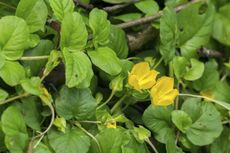Ground Cover
Ground cover plants deserve a place of their own. These versatile plants add appeal to nearly any garden design - in the garden itself, along hillsides, or in containers. There are many types of ground cover available, so finding one that fits your needs should be easy. But their spreading nature can quickly get out of hand if proper selection or ground cover care is not taken. That said, we can help put these worries at ease. Keep reading to learn what types of ground cover plants are suitable for growing in your region and how to care for them.
Ground Cover
-

Lilyturf Cold Tolerance: How To Care For Liriope In Winter
Though evergreen, liriope in winter will naturally enter into a stage of dormancy in which growth of the plant foliage ceases. For the best results, homeowners will need to begin the process of winterizing liriope plants. Learn more in this article.
By Tonya Barnett
-

English Ivy Pruning: Tips On How And When To Trim Ivy Plants
Whether English ivy is grown indoors or out, this fast-growing plant benefits from an occasional trim to stimulate new growth, improve air circulation, and keep the vine within boundaries and looking its best. Learn more in this article.
By Mary H. Dyer
-

Tips For How To Kill English Ivy
The same traits that make English ivy a wonderful ground cover can also make it a pain to remove from your yard. Removing ivy can be a difficult task, but not an impossible one. This article will help.
By Heather Rhoades
-

Vinca Vine Alternatives In Gardens: What To Plant Instead Of Vinca Vine
It can be appealing as an alternative to grass but before using periwinkle, try these alternatives to vinca vine. Click here for options.
By Mary Ellen Ellis
-

Growing Golden Stars - How To Grow And Care For Green And Gold Plant
Golden star plants produce an abundance of bright, yellow-gold flowers from spring until autumn. They are ideal for an area that needs a continuous, uniform ground cover. Learn more in this article.
By Jackie Carroll
-

What Is A Fir Clubmoss Plant?
Fir clubmosses are tiny evergreens that look like little conifers. These ancient plants have an interesting past. Read this article to find out more about the fir clubmoss plant, where it grows and what it looks like. Click here.
By Jackie Carroll
-

Part Sun And Shade Ground Cover For Every Garden
Groundcovers in your bed or border offer a finished appearance. Read on for groundcovers for part sun and shade conditions.
By Becca Badgett
-

5 Fragrant Groundcover Plants
Adding fragrant groundcover plants to a special nook in the garden or a walkway can add a punch of “wow” when passersby catch the aroma. Click for more.
By Susan Albert
-

Dichondra Plant Info: Tips For Growing Dichondra In The Lawn Or Garden
In some places dichondra is seen as a weed. In other places, it is valued as an attractive ground cover or even a substitute for a small lawn area. Find out more about how to grow dichondra ground cover here.
By Susan Patterson
-

Potentilla Groundcover: How To Grow Creeping Potentilla In Gardens
Potentilla ground cover is perfect for moist, cool, partly shady sites. Its lemony-colored flowers that last all spring and strawberry-scented foliage make it irresistible. Find out more about this ground cover in this article.
By Jackie Carroll
-

Crinkle-Leaf Creeper Info: Learn How To Grow Crinkle-Leaf Creeper Plants
Crinkle-leaf creeper, also commonly known as creeping raspberry, is an excellent example of that durability and versatility. It is perfect for difficult sites and produces a mat of attractive foliage with unmatchable resistance to many pests and diseases. Learn more here.
By Bonnie L. Grant
-

Creeping Jenny Control: What Is The Best Way To Manage Creeping Jenny
Unless you specifically want it as groundcover in a spot where nothing else grows, you should work on controlling creeping jenny as soon as you spot it. Learn more about how to get rid of creeping jenny in the garden with tips from this article.
By Liz Baessler
-

Mazus Groundcover: Growing Mazus Reptans In The Garden
Mazus ground cover is a tiny perennial plant, growing only two inches tall. It forms a dense mat of foliage that stays green throughout spring and summer, and well into fall. In the summer, it is dotted with tiny blue flowers. Learn to grow mazus in this article.
By Jackie Carroll
-

Taking Creeping Phlox Cuttings: How To Grow Creeping Phlox From Cuttings
Creeping phlox cuttings root after a few months, readily providing new plants almost effortlessly. Timing is everything when taking creeping phlox cuttings. Learn how to take cuttings from creeping phlox and when to do it for maximum success here.
By Bonnie L. Grant
-

Potted Clover Plants: Can You Grow Clover As A Houseplant
Do you want to grow your own lucky 4-leaf clover as a houseplant? Although these grow rampantly outdoors, it is possible to grow clover in a container indoors provided that you give them the conditions it likes. Learn what those are in this article.
By Raffaele Di Lallo
-

Full Sun Groundcover Plants – Planting Groundcover In the Sun
Groundcover plants for sunny locations perform a variety of functions. Need some suggestions? Click here for full sun groundcover plants.
By Bonnie L. Grant
-

Bishop’s Weed Reversion – Learn About Variegation Loss In Bishop’s Weed
Bishop's weed plant may be just the thing for tough areas with poor soil or excessive shade; it will grow where most plants are doomed to fail. That being said, a snow on the mountain losing color can be alarming. Click here to learn more.
By Mary H. Dyer

